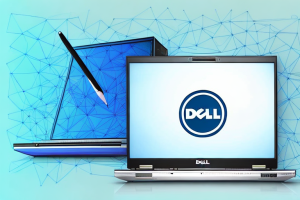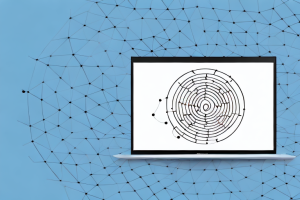How to connect a Dell Inspiron 13 to an external monitor
7 min read
A dell inspiron 13 laptop connected to an external monitor
If you have a Dell Inspiron 13 laptop and want to extend your display to an external monitor, you may be wondering how to go about it. Fortunately, connecting an external monitor to your Dell Inspiron 13 is a straightforward process that can be done using one of several ports that come with the laptop. In this article, we will go over the steps to connect your Dell Inspiron 13 to an external monitor, as well as configuring and adjusting display settings.
Understanding the Dell Inspiron 13 ports
The Dell Inspiron 13 laptop comes with several ports, each with a different purpose. These ports include: a USB-C port, a USB 3.0 port, an HDMI port, a headphone jack, a microSD card slot, and a security lock slot. For connecting your laptop to an external monitor, you will need to use either the HDMI port or the USB-C port (with an adapter).
The USB-C port on the Dell Inspiron 13 laptop is a versatile port that can be used for charging your laptop, transferring data, and connecting to external displays. It supports Thunderbolt 3 technology, which means you can connect up to two 4K displays or one 5K display to your laptop using a single cable. Additionally, the USB 3.0 port on the laptop can be used for connecting external hard drives, flash drives, and other USB devices.
Identifying the correct external monitor port for your Dell Inspiron 13
If your external monitor has an HDMI port, you can connect it directly to your laptop using an HDMI to HDMI cable. If your external monitor has a VGA port, you can use an HDMI to VGA adapter, along with an HDMI cable and a VGA cable. If your external monitor has a DisplayPort, you can use a USB-C to DisplayPort adapter, along with a USB-C cable and a DisplayPort cable.
It is important to note that not all Dell Inspiron 13 laptops have the same external monitor ports. Some models may have additional ports such as DVI or Thunderbolt. It is recommended to check your laptop’s specifications or user manual to determine which ports are available.
When connecting your laptop to an external monitor, it is also important to adjust the display settings to ensure the best viewing experience. You can do this by going to the “Display” settings in your laptop’s control panel and selecting the appropriate resolution and orientation for your external monitor.
Connecting a VGA cable to your Dell Inspiron 13 and external monitor
If your external monitor does not have an HDMI port, but instead has a VGA port, you can connect your Dell Inspiron 13 to the monitor using a VGA cable. First, turn off your laptop and external monitor. Then, connect one end of the VGA cable to the VGA port on your external monitor, and the other end to the VGA port on your Dell Inspiron 13. Finally, turn on your laptop and monitor, and the display should automatically extend to the external monitor.
It is important to note that when using a VGA cable, the maximum resolution that can be displayed on the external monitor may be limited. This is because VGA is an older technology and has a lower maximum resolution compared to HDMI or DisplayPort. If you require a higher resolution display, it is recommended to use an HDMI or DisplayPort cable instead.
Additionally, if you experience any issues with the display not extending to the external monitor, you may need to adjust the display settings on your Dell Inspiron 13. To do this, right-click on the desktop and select “Display settings”. From there, you can choose to extend or duplicate the display, and adjust the resolution and orientation of the external monitor.
Connecting an HDMI cable to your Dell Inspiron 13 and external monitor
If your external monitor has an HDMI port, you can connect your Dell Inspiron 13 to the monitor using an HDMI to HDMI cable. First, turn off your laptop and external monitor. Then, connect one end of the HDMI cable to the HDMI port on your external monitor, and the other end to the HDMI port on your Dell Inspiron 13. Finally, turn on your laptop and monitor, and the display should automatically extend to the external monitor.
It is important to note that some external monitors may require additional settings to be adjusted in order to display properly. You may need to access your laptop’s display settings and select the option to extend the display to the external monitor. Additionally, some monitors may require you to manually switch the input source to HDMI in order to display the laptop’s screen.
If you encounter any issues with the display, such as the image appearing blurry or stretched, you may need to adjust the resolution settings on your laptop. This can be done by accessing the display settings and selecting a resolution that is compatible with your external monitor.
Using a DisplayPort cable to connect your Dell Inspiron 13 and external monitor
If your external monitor has a DisplayPort, you can connect your Dell Inspiron 13 to the monitor using a USB-C to DisplayPort adapter, along with a USB-C cable and a DisplayPort cable. First, turn off your laptop and external monitor. Then, connect one end of the USB-C cable to the USB-C port on your Dell Inspiron 13, and the other end to the USB-C to DisplayPort adapter. Connect one end of the DisplayPort cable to the DisplayPort port on your external monitor, and the other end to the DisplayPort port on the adapter. Finally, turn on your laptop and monitor, and the display should automatically extend to the external monitor.
It is important to note that not all USB-C to DisplayPort adapters are created equal. Make sure to choose an adapter that is compatible with your Dell Inspiron 13 and external monitor, and that supports the resolution and refresh rate you require. Additionally, if your external monitor does not have a DisplayPort, you may need to use a different type of adapter, such as HDMI or VGA.
Configuring display settings on your Dell Inspiron 13 for an external monitor
Once you have successfully connected your Dell Inspiron 13 to an external monitor, you may need to configure some display settings for the external monitor. To do this, right-click on the desktop and select display settings. From there, you can change the resolution of the external monitor, select duplicate display or extend display mode, and rearrange your displays.
It is important to note that not all external monitors will be automatically detected by your Dell Inspiron 13. If your external monitor is not being recognized, you may need to manually install the drivers for the monitor. You can usually find these drivers on the manufacturer’s website or on the CD that came with the monitor. Once the drivers are installed, you should be able to configure the display settings as usual.
Adjusting screen resolution on your Dell Inspiron 13 for an external monitor
If the resolution of the external monitor is not optimal, you can change it in display settings. Under scale and layout, select the resolution that works best for your external monitor.
It is important to note that changing the resolution of your external monitor may affect the performance of your Dell Inspiron 13. If you notice any lag or slow response time, you may need to adjust the resolution to a lower setting.
Additionally, if you are using your Dell Inspiron 13 for gaming or graphic design, it is recommended to use a monitor with a higher resolution for optimal performance. You can also adjust the refresh rate in display settings to reduce screen tearing and improve overall visual quality.
Enabling duplicate or extended display mode on your Dell Inspiron 13
If you want to duplicate or extend your display to the external monitor, you can select the appropriate option in display settings. Duplicate display mode will show the same content on both your laptop screen and external monitor, while extended display mode will show different content on each display.
It is important to note that not all external monitors may be compatible with your Dell Inspiron 13. Before attempting to connect an external monitor, ensure that it is compatible with your laptop’s graphics card and has the necessary ports for connection. Additionally, make sure to adjust the resolution settings on both your laptop and external monitor to ensure optimal display quality.
Troubleshooting common issues when connecting a Dell Inspiron 13 to an external monitor
If you experience any issues when connecting your Dell Inspiron 13 to an external monitor, there are several steps you can take to troubleshoot the problem. First, make sure the cable connections are secure and the monitor is turned on. If the external monitor is not displaying content, try pressing the Windows logo key and the P key simultaneously to switch between display modes. If the problem persists, update your graphics driver or contact Dell support for further assistance.
Overall, connecting a Dell Inspiron 13 to an external monitor is a simple and convenient way to expand your workspace. With the right cable and a few clicks of a button, you can easily configure your laptop and monitor to work together seamlessly.
It is important to note that not all external monitors are compatible with the Dell Inspiron 13. Before purchasing an external monitor, make sure to check the specifications and ensure that it is compatible with your laptop. Additionally, some external monitors may require additional software or drivers to function properly. Be sure to check the manufacturer’s website for any necessary downloads or updates.


